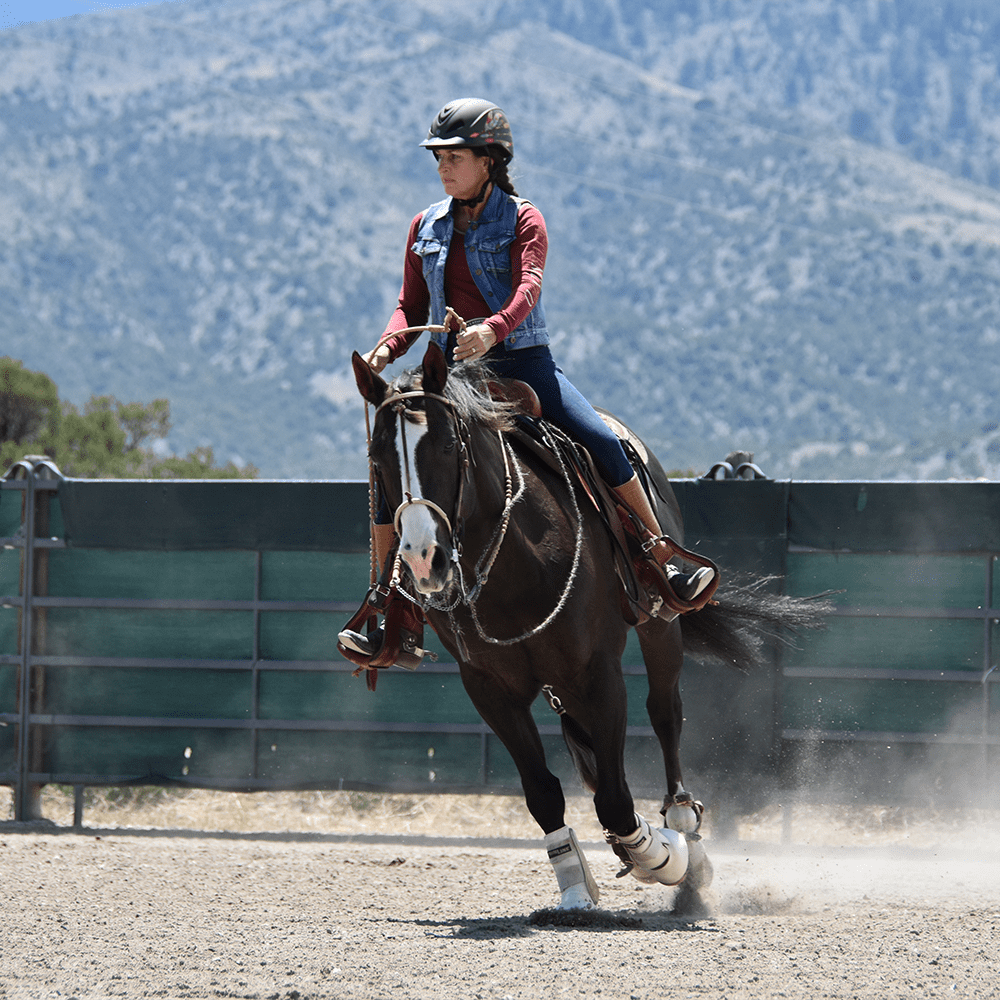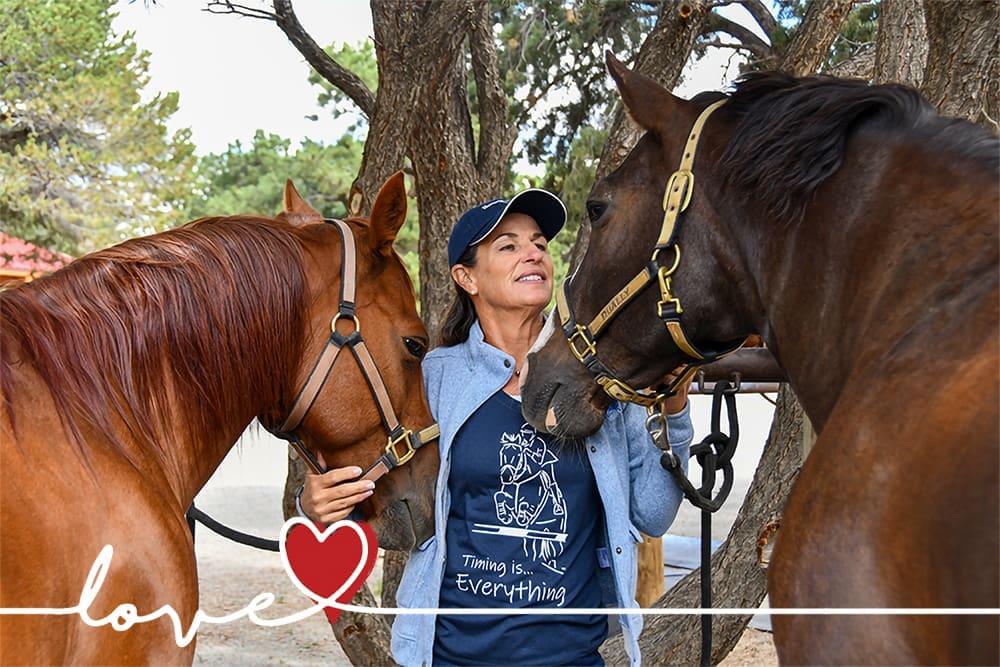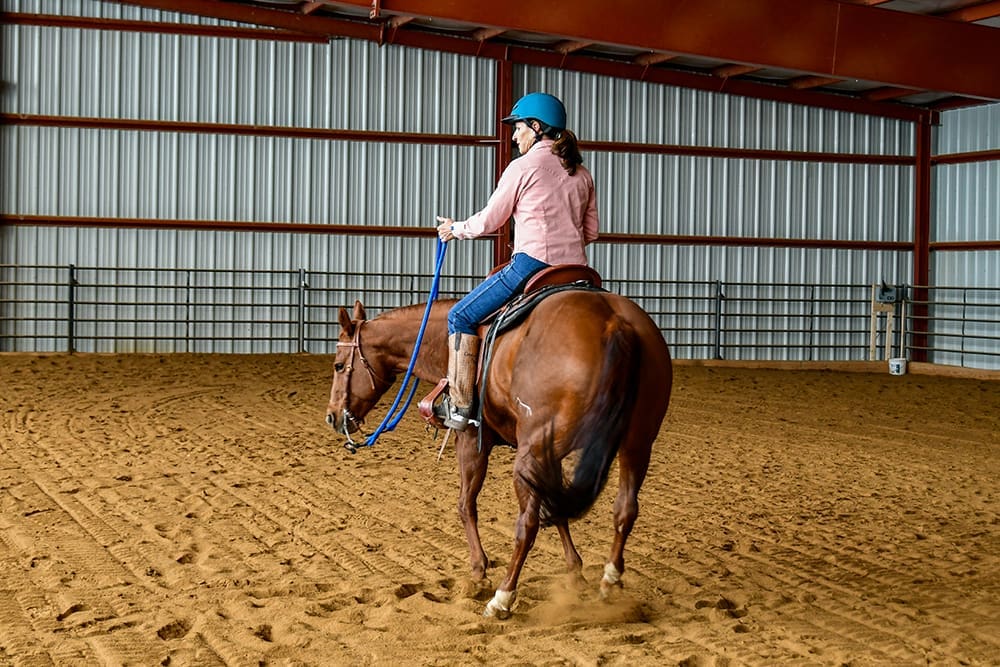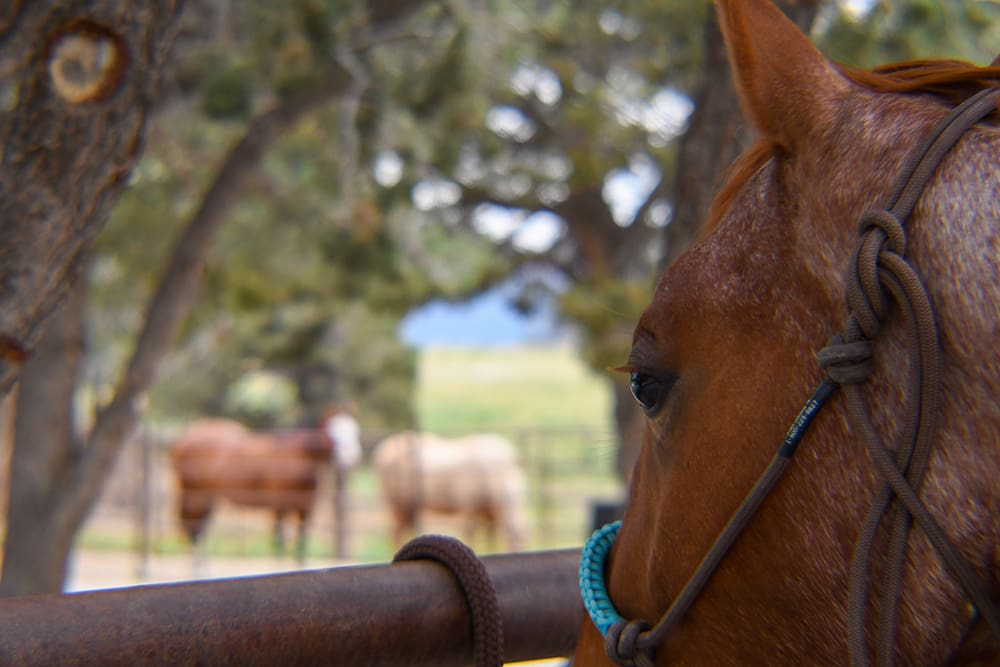One thing horses are really good at is being present in the moment. People, not so much. We tend to carry baggage from the past and stress about the future, but not stay present with our horse in the moment. Wouldn’t it be nice if you could stay present and thinking in the moment and ride through any sticky situation with your horse?
Riding an unfamiliar horse, or riding in a new situation like a clinic or a big trail ride, or when riding a horse that was less-than-trustworthy in the past, are typical times when I see people lock up and shut down on their horses. When the rider shuts down, the horse’s behavior deteriorates under the pressure of a fearful, untrusting and clenching rider. It goes something like this…
The horse triggers an emotional response in the rider, then a chain reaction of events occurs between the rider and the horse, which results in gasping, clenching, hollowing and bracing on the part of both rider and horse. Pretty soon the rider has a death grip on the reins, pulling back and manually steering the horse’s nose every inch of the ride, instead of guiding direction and letting the horse move forward and do his job. Soon the horse is high headed and defiant; rooting the reins and starting to act like a bull in a china shop. Resistant behavior in horses tends to amp up fearful behavior in riders, leading to more clenching, gasping and hollowing. And the downward spiral continues.
Riding in the moment is not the same as having no fear. It requires the mental discipline to be aware of your surroundings, objectively reading your horse’s mood and responsiveness, trusting your horse to do his job but being prepared to react if he doesn’t. Riding the horse that is beneath you means that you are present in the moment with him, not thinking about what could go wrong or a past incident. It means responding to your horse with both praise and admonishment as needed, and giving him every opportunity to be a good horse, not doubting his every move.
Riding a thousand-pound flight animal certainly comes with risk; there’s nothing we can do to totally eliminate that but when all you think about is what can go wrong, it affects your riding in very negative ways. The horse becomes anxious and resistant, which generally increases the fear in the rider, creating a snowball effect. The keys to riding in the moment and riding through problems are to have awareness, to think through and ride through it, to have a deep and anchored seat and to be relaxed but prepared—with both physical and mental skills.
Prey and the Herd Mentality
It’s hard for us to remember, but horses are prey animals and they worry about their safety a lot. That’s one reason why they crave strong leadership and authority—it makes them feel safe. The leader of the herd is responsible for keeping the herd safe, leading them to food and water when it’s time and maintaining order in the herd. It’s only possible for your horse to think of you as the leader (and therefore be confident going anywhere with you) if you act this way—thinking through the problems and taking charge. When the rider is scared, dodgy, and unaware of things going on around her, it worries the horse.
Horses also have an incredibly strong herd instinct, known as gregarious behavior—they are instinctively drawn to the herd. Because horses are both prey and herd animals, they are hard-wired to adopt the emotions of the animals around them—when one horse in the herd startles, they all do. This emotionality carries over to people as well. When the rider gets fearful, the horse knows it and can’t help but feel anxious too. If the rider is constantly thinking about what can go wrong, the horse becomes suspicious and anxious too.
The horse looks to his rider to set the tone—be it relaxed or tense; confident or insecure; leader or follower. It would be unreasonable to say you should never to have any fear or anxiety; that’s impossible. But what is possible, is not to let that emotion creep into your body language and your actions and succumb to the paralysis it can cause. Having good mental discipline and an awareness of your posture, your body language, your eyes and your breathing, will help settle your horse and give him more confidence in you.
Presumptive Leadership
To be a strong and confident leader for your horse, you need to develop a presumptive quality in your demeanor—presume everything will go well, presume your horse will respond as he is trained to do, presume that your horse agrees you are the one in charge and that you have complete control. Horses really dig that kind of strong leadership.
Set a positive tone for the ride– visualize the best outcome; keep your eyes engaged and ride with a destination in mind—be a proactive rider, not one that devolves into a clenching, gasping, red-faced mess. When things go awry, ride forward—go somewhere—take action—redirect your horse. Don’t pull back, clench the reins and try to stop the ride and get off.
When something scary happens on your ride, divert attention rather than focus on the scary thing. Perfect the art of shifting gears and doing something else, not stopping in paralysis. Riding forward is usually better than stopping since forward motion is the basis of all training. Since horses are flight animals, they generally respond better when they are moving than when forward motion is inhibited. When a horse is anxious, it’s generally easier to control the forward motion of the horse than it is to stop all motion and try and contain it.
Look around, find a destination and ride there. Ask the horse to move forward then direct that movement. Throw in some turns and changes of direction to establish even more control. Be a pro-active rider in times of stress, not a victim.
Be Prepared but Relaxed
When you have the riding skills and mental skills you need to control a horse in almost any situation, it will give you great confidence. This has a positive effect on your horse as well, because when you are confident in yourself, your horse feels more confident in you too. When you have confidence in yourself, your horse is far less likely to challenge your authority (see the comments above on being presumptive). The riding and mental skills needed, include having a balanced position in the saddle with an anchored seat, keeping your eyes up and focused on your environment and staying objectively aware of your horse, breathing deeply and rhythmically, and knowing effective emergency stopping techniques.
Beyond basic riding position (ear-shoulder-hip-heel alignment), having a deep and anchored seat means that you are sitting back, weighted in your heels, your lower back is in a “J” shape and your joints are loose and relaxed. From this position, almost nothing can get you off the horse. But fear and anxiety will do the opposite to your position if you allow it—your back hollows, you perch forward, your heels come up, your joints stiffen (causing you to bounce and your horse to hollow his back and throw his head up), you clench the reins and pull yourself even more forward—all of this is transmitting fear and panic to your horse.
Develop your mental skills so that when the going gets tough, you automatically sit back, round your lower back, get weighted in your heels, keep your eyes up and engaged and your breathing deep. Ride pro-actively and go somewhere!
It’s also important to develop your riding skills and have a full understanding emergency stopping techniques and when to use them. Learn the one-rein stop for times when your horse is acting up or getting a little frisky; however, the one-rein stop should not be used when a horse is bolting because it could cause him to trip and fall. The emergency stopping rein (a/k/a the “pulley” rein) is an important skill that all riders should learn.
The pulley rein is like a one-rein stop, except the outside rein is fixed and locked on the crest of the neck, so it will not cause a turn. When executed properly, the pulley rein generates leverage and will allow the rider to stop any horse on a dime. It’s not often taught because not all instructors/trainers know it and because the practicing of it is hard on the horses. However, if you don’t practice the maneuver, you certainly won’t be able to employ it when your horse is bolting. You can read articles and watch videos about the pulley rein here.
Awareness, Knowledge and Skill
When it comes to riding horses, nothing gives you more confidence than knowledge and skill. Being aware of your environment, being balanced in the saddle and anchored in your seat, staying in the moment, being aware of your horse’s behavior, riding proactively, with purpose and intent will get you through almost any tricky situation with a horse. Armed with knowledge, skills and mental discipline, you will have the confidence you need to get the job done!




